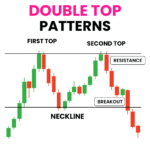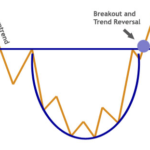The triple top pattern is a bearish reversal pattern that signifies a likely change in trend direction. It consists of three peaks at the same level, indicating a struggle between buyers and sellers. After three unsuccessful attempts to break above a resistance level, the pattern suggests a shift from an uptrend to a downtrend. The confirmation of a triple top occurs when the support level is broken, leading to a downtrend.
Traders use this pattern to identify overvalued prices and anticipate selling pressure. The triple top pattern typically takes three to six months to form and is characterized by decreasing volume with each peak. It is crucial to confirm the pattern with a close below the lower trendline and above-average volume. This pattern serves as a signal for traders to consider exiting long positions or entering short positions.
how to identify a triple top pattern on a chart
To identify a triple top pattern on a chart, look for three consecutive peaks at or near the same level, signaling a potential trend reversal from an uptrend to a downtrend.
Here are the key steps to identify a triple top pattern:
- Three Peaks: Search for three distinct highs that are approximately at the same level. These peaks represent the price reaching a resistance level multiple times without breaking above it.
- Resistance Level: The peaks should be followed by a pullback between each peak, indicating a struggle between buyers and sellers at a specific resistance level.
- Confirmation: The pattern confirms a triple top when the price breaks below the support level, indicating a shift in trend direction from bullish to bearish.
- Volume Analysis: Pay attention to the volume during the formation of the pattern. A sharp increase in volume during the decline off the resistance level can signal a higher probability of a support break.
- Neckline Break: The neckline, which is the support level connecting the lows between the peaks, is a crucial element. A break below this neckline confirms the activation of the triple top pattern.
- Trading Strategy: Traders can consider entering short positions or exiting long positions once the pattern is confirmed. Setting stop-loss orders above the neckline and identifying take-profit levels based on the pattern’s height can help manage the trade effectively.
By following these steps and analyzing the price action on the chart, traders can successfully identify a triple top pattern and make informed trading decisions based on this bearish reversal signal.
what is the significance of the price pullbacks between the peaks in a triple top pattern
The significance of the price pullbacks between the peaks in a triple top pattern lies in indicating a struggle between buyers and sellers at a specific resistance level. These pullbacks represent a temporary retreat in price after each peak, reflecting a battle between bullish and bearish forces. The pullbacks are crucial as they demonstrate the inability of the price to break above the resistance level despite multiple attempts, highlighting a strong selling pressure at that level.In a triple top pattern:
- Three Peaks: The three peaks at or near the same level show repeated failed attempts to breach the resistance.
- Pullbacks: The pullbacks between the peaks signify profit-taking by traders or hesitation to push the price higher, revealing a weakening bullish momentum.
- Resistance Level: The resistance level is established by these peaks, and the inability to surpass this level during the pullbacks indicates a shift in market sentiment.
- Confirmation: A break below the support level after the third peak confirms the pattern, signaling a reversal from an uptrend to a downtrend.
Overall, the price pullbacks between the peaks in a triple top pattern serve as critical indicators of market dynamics, showing where buyers are losing strength and sellers are gaining control. This pattern helps traders identify potential trend reversals and make informed decisions about entering short positions or exiting long positions.


